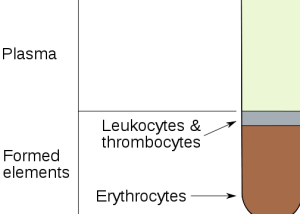Hematocrit level refers to the proportion of red blood cells present in an certain volume of blood. It is measured in percentage. So, a 40 percent hematocrit level indicates that the red blood cells are present in the quantity of 40 milliliters of red blood cells per 100 milliliters of blood.
Hematocrit forms a part of the complete blood count that includes white blood cell count, hemoglobin concentration and platelet count.
Tests to check hematocrit levels are usually conducted to check for deficiencies in the blood or the presence of medical condition such as anemia, deficiencies of diet or malnutrition, leukemia or some other disease.
Once a sample of blood is obtained from an individual, the hematocrit levels can be checked using an automated machine. The machines do not directly measure the hematocrit levels but take several measurements concurrently. Based on those measurements, the machines calculate the hematocrit levels after determining the average red blood cells volume and the quantity of hemoglobin.
There are some manual methods to determine hematocrit levels. Such methods use a centrifuge, causing the red blood cells to collect at the bottom of the tube. The hematocrit levels can then be visually measured.

Normal Hematocrit Levels
The normal levels of hematocrit vary between laboratories and depend on the age and gender of individuals. The normal hematocrit levels are listed below:
Newborns: 54 percent to 67 percent
Such high levels of hematocrit are required for the growth and development of the child.
One week of age: 46 percent to 64 percent
One month of age: 36 percent to 48 percent
Three months of age: 31 percent to 37 percent
One year of age: 30 percent to 42 percent
Ten years of age: 35 percent to 41 percent
Adult males: 41 percent to 55 percent
Adult women: 37 percent to 45 percent
Low levels of hematocrit
When an individual has low hematocrit levels that that person may be anemic. Some of the reasons for anemia are severe loss of blood due to injuries, surgery, etc., deficiencies in nutrients such as vitamin B12, iron, folate, problems of the bone marrow such as cancer of the bone marrow, failure of the kidneys and adverse effects of chemotherapy medications. Sickle cells anemia is also an abnormal hematocrit condition.
Low levels of hematocrit leads to severe impairment of daily life and its activities
Elevated or high levels of hematocrit
Elevated or high levels of hematocrit are usually present in individuals who smoke excessively and chronically. In addition, individuals who live at higher altitudes also suffer from high hematocrit levels.
Dehydration may result in increased levels of hematocrit that is usually reduced by fluid intake and the restoration of liquid balance in the body.
Diseases of the lungs, bone marrow disorders such as polycythemia rubra vera and doping of the blood by athletes through the abuse of drugs like erythropoietin also lead to elevated levels of hematocrit
Treatment of abnormal hematocrit levels
Elevated or low levels of hematocrit are usually associated with certain medical or body conditions and illnesses.
Once the medical illnesses are diagnosed and treated by a doctor, the hematocrit levels will return to normal levels.
I have elevated hematocrit and elevated hemoglobin results in my CBC test. I am not a smoker or use medication known to cause elevation. What could be contributing factors?